#224 Tomorrow's picture: January 29, 1996

“The dramatic and mysterious looking object revealed in this Hubble Space Telescope image is known as the Egg Nebula. It is an aging star about 3,000 lightyears distant, entering its Planetary Nebula phase of evolution. Surrounded by an expanding cloud of gas and dust, a dense cocoon of dust (seen as the dark band running diagonally across the center) encloses the star itself and blocks it from direct view. The searchlight appearance is created as light from the star shines more easily through the thinner parts of the cocoon. Dust particles in the expanding cloud scatter and reflect the starlight making the beams visible. The sharpness of the HST image reveals a wealth of detail which will help to understand this complex and spectacular part of the stellar lifecycle."
Copyright: Public domain
#225 Tomorrow's picture: January 30, 1996
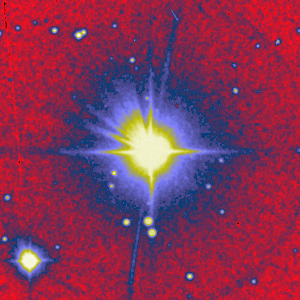
“The star 70 Virginis has a planet. This recent discovery is the second known case of a planet orbiting a normal star other than our Sun itself. The first case involved 51 Pegasi and was announced last year. The star 70 Vir, shown in the center of the above false-color picture, is very much like the Sun. The planet is not visible above - the unusual structure surrounding the star is caused by the telescope. The planet, designated 70 Vir b for short, was discovered by very slight periodic shifts in its colors. Defining characteristics of this planet include that it is at least eight times the mass of Jupiter, it's orbit is much smaller than Jupiter's, and it's temperature allows water to exist in liquid form - like on the Earth. Life on Earth is based on liquid water - could life exist here too?"
Copyright: Royal
Observatory Edinburgh, Anglo-Australian Observatory, and AURA
#226 Tomorrow's picture: January 31, 1996
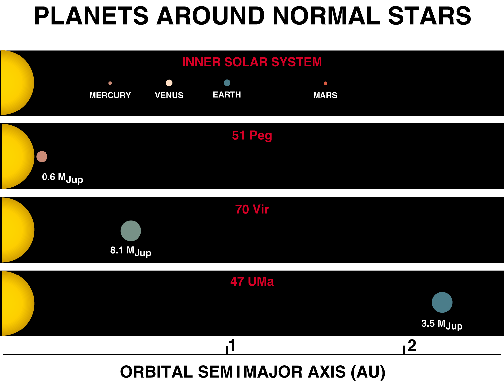
“Do many Sun-like stars have planets? Speculation on this point has been ongoing since humanity's realization that other stars existed. Only in the past year, however, have answers and discoveries been realized. The above plot summarizes the four known cases of normal stars having planets. These cases are: our Solar System, 51 Pegasi, 70 Virgini, and 47 Ursae Majoris. The later two cases were discovered by astronomers led by Geoff Marcy and Paul Butler as part of a greater project inspecting 120 stars for orbiting planets. Interestingly enough, the planets around the later two stars have temperatures in the right range to allow liquid water - and hence may have conditions ripe for the development of life."
Copyright: Public domain
#227 Tomorrow's picture: February 01, 1996
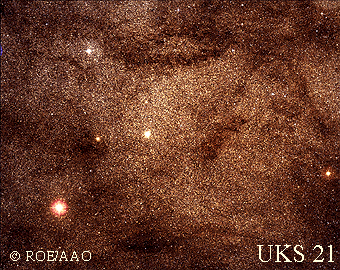
“What is the shape and composition of our Milky Way Galaxy? This question would be easier to answer if there wasn't so much obscuring dust! In the 1940s, however, astronomer Walter Baade identified a "window" near the center of our Galaxy where there is comparatively little opaque dust. Now called "Baade's Window", this sky region contains millions of stars and is used for many studies of the distant Milky Way. One clever use, devised by Bohdan Paczynski, is to monitor millions of stars in our Galactic Bulge - many through Baade's window - for sudden brightening due to gravitational lensing. Current observations by the OGLE and MACHO collaborations have now identified dozens of gravitational amplification events. This unexpectedly large number supports previous claims that our Galaxy has a "bar" of stars across the central nucleus, pointed nearly at the Sun."
Copyright: Anglo-Australian Telescope
Board
#228 Tomorrow's picture: February 02, 1996
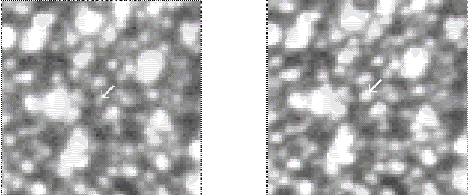
“What is our Galaxy made of? Stellar motions indicate there is much more mass than just stars and gas. Photographs like the two shown above may be yielding a clue about the dark matter, however. Pictured is the first recorded instance of a dim star in our Galaxy moving in front of a bright background star, shown by the arrow, deflecting light around it, and causing the background star to appear much brighter (right frame). Were our Galaxy made predominantly of MAssive Compact Halo Objects (MACHOs), many similar such gravitational lensing events would be expected when photographing the Large Magellanic Clouds (LMC) - hence indicating the presence of MACHO lenses in our Galaxy. A research team led by Charles Alcock this month claimed enough LMC gravitational lensing events to indicate at least half of the dark matter in our Galaxy is composed of MACHOs. This spectacular claim may well be correct - but awaits crucial testing with future observations and modeling."
Copyright: Public domain
#229 Tomorrow's picture: February 03, 1996
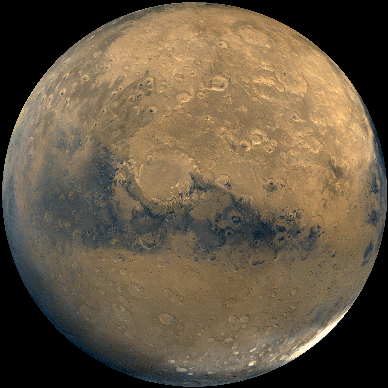
“What hit Mars? The impact crater Schiparelli near the center of the above image was likely caused by a collision with an object the size of an asteroid. Also evident in this full face mosaic of Mars are numerous craters from many other impacts with smaller objects over billions of years. At the lower right, white carbon dioxide frost can be seen in the Hellas basin. The frost forms because temperatures can drop as low as -140 degrees Celsius on Mars. Some Martian regions, however, occasionally reach as high as 20 degrees Celsius - a typical room temperature here on Earth."
Copyright: Public domain
#230 Tomorrow's picture: February 04, 1996
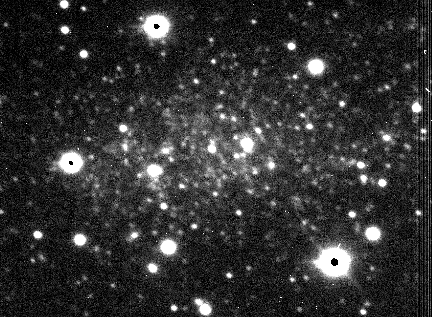
“What's the closest galaxy to our Milky Way? For many years astronomers thought it was the Large Magellanic Cloud (LMC). But the seemingly insignificant fuzzy patch shown above turned out to be part of a galaxy that is even closer. Deemed the "Sagittarius Dwarf", this small galaxy went unnoticed until its discovery in 1994 by R. Ibata, G. Gilmore and M. Irwin (RGO). The reason the Sagittarius Dwarf hadn't been discovered earlier is because it is so dim, it is so spread out over the sky, and there are so many Milky Way stars in front of it. The distance to the Sagittarius Dwarf was recently measured to be about one third of the distance to the LMC. Astronomers now believe that this galaxy is slowly being torn apart by the vast gravitational forces of our Galaxy."
Copyright: A. Oksanen2.5 meter Nordic
Optical Telescope
#231 Tomorrow's picture: February 05, 1996
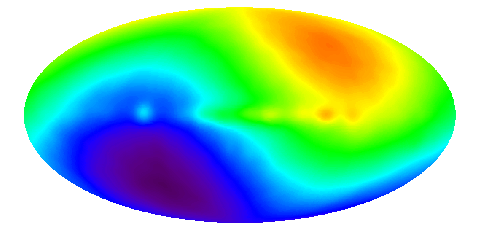
“Our Earth is not at rest. The Earth moves around the Sun. The Sun orbits the center of the Milky Way Galaxy. The Milky Way Galaxy orbits in the Local Group. The Local Group falls toward the Virgo Cluster of Galaxies. But these speeds are less than the speed that all of these objects together move relative to the microwave background. In the above all-sky map, radiation in the Earth's direction of motion appears blueshifted and hence hotter, while radiation on the opposite side of the sky is redshifted and colder. The map indicates that the Local Group moves at about 600 kilometers per second relative to this primordial radiation. This high speed was initially unexpected and its magnitude is still unexplained. Why are we moving so fast? What is out there?"
Copyright: Public domain
#232 Tomorrow's picture: February 06, 1996

“Above are two microwave images of the sky, looking north and south of our galaxy's equator, based on data from NASA's COBE satellite. After computer processing to remove contributions from nearby objects and the effects of the earth's motion, they show "spots". These spots are the oldest structures known - probably the oldest structures humanity will ever know. They are also the most distant. As our universe expanded and cooled, conglomerations of mass formed - these are some of the first. They confirm that only a million years after the big-bang - which occurred roughly 15 billion years ago - parts of the universe were visibly hotter than other parts. By studying the size and distribution of the spots found with COBE and future missions, astronomers hope to learn what matter and processes caused the spots to form - and hence determine the composition, density, and future of our universe."
Copyright: Public domain
#233 Tomorrow's picture: February 07, 1996
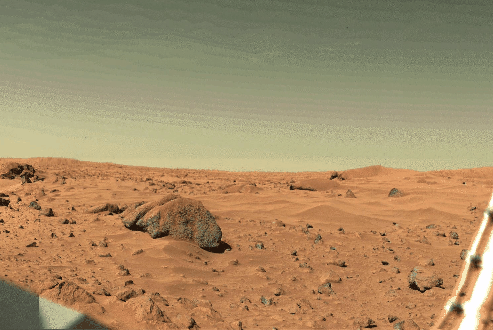
“If you could stand on Mars - what would you see? Viking 1 robot landers answered this question in 1976 with pictures like the one shown above. The dark rocks, red soil, and green-tinged sky grace this rendition of a normal Martian afternoon. At the bottom corners of the picture are portions of Viking spacecraft. The red color of the rocks is caused by an abundance of iron in the soil. The Martian surface is covered by rocks, huge craters, fantastic canyons, and gigantic volcanoes that dwarf any on Earth. No life has been found, but some speculate that since not all spacecraft reaching Mars from Earth had been fully decontaminated, Earth born microbes might live there now."
Copyright: Public domain
Upvote! Resteem! Comment! As you like it! Thank you for attention!
Congratulations @george-zagraid! You have completed some achievement on Steemit and have been rewarded with new badge(s) :
Click on any badge to view your own Board of Honor on SteemitBoard.
For more information about SteemitBoard, click here
If you no longer want to receive notifications, reply to this comment with the word
STOP